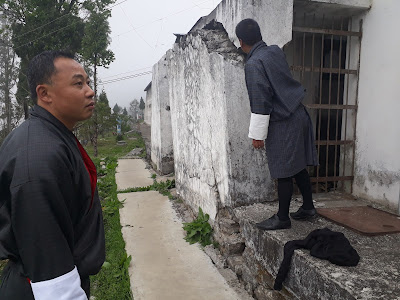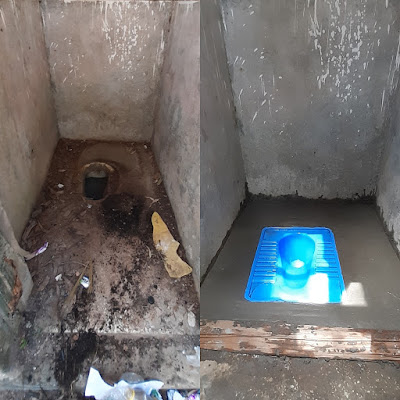It was in 1997 that I maintained my first journal. My English teacher in Class VII, Sir Karma Wangchuk gave us the assignment to record our day in a small notebook to build our writing skill. The class captain had to collect our journals and take to him for review every evening. We would get it back the next morning with his feedback. Back in the days, we could hardly write an intelligible sentence. We put him off every day.
One day, by a great stroke of luck I got one sentence correct. I still remember that sentence after all these years, it read "Thinley Gyeltshen left the school on his own accord." My poor English teacher was overjoyed. The remark he left in my little diary had a big impact on me: "Beautiful Sentence. Keep it up!". I kept writing hard to get better remarks from him each day.
It was my teacher Karma Wangchuk who named me PaSsu. He was fond of Haap's accent and found it too funny to call me PaSsu, as a Haap would do, instead of Passang or Passa. I liked it so much and proudly kept it as my pet name.
Knowing him from Junior School to College, he wouldn't be easily impressed but he was openly proud when I handed him a copy of my book PaSsu Diary in 2018. It made a complete circle. It was he in whose class I began journaling and I came to be known as a blogger by the name he gave me, and finally, here he was holding my book.
Back in March, Among his students who had established a lifelong friendship with him, there were three of us who made it to the funeral despite restrictions due to covid19. We stayed till the end with the members of his family. I stayed till the end because I wanted to his ashes being cast into the river to be washed into the sea and feel the sense of him becoming a part of nature that he loved so much. I thought to myself that he would have loved this part.
With his death, we lost a living encyclopaedia on the natural world. He would talk about butterflies as if he lived among them. He knew orchids like he had an orchid farm. He could talk endlessly about a bird just by hearing its distant sound. He knew wild animals like a farmer knew his farm animals. He loved wild cats the most and have all the species of it painted.
His life was simple- the guy seemed to have known the true essence of life already- he spent all his saving during the vacations to explore the wilderness or travel to a historic site. His notes, painting and photographs from the wilderness will very well make up several volumes of books. But he never published anything. I don't think he ever regretted that because he just loved doing it. Publication or exhibition never bothered him. He once told me, "I will always have my side of the story to tell which no one can own. The challenge is even more exciting."

In 1998, I took the only white t-shirt I had to him and requested him to paint something on it for keepsake. He did a black-necked crane on it effortlessly. The shirt didn't last for long but I managed to cut out the crane and preserve it (See pic). He was one of the finest artists I have known and the first to introduce me to art. His favourite subjects were his cousins from the wilderness; there are hundreds of paintings of birds, orchids, mammals, cats, etc. some from as early as 1987 when he was a boy himself. He never exhibited his artworks. In fact, his works were taken by others and published in their books, when he could easily do his own.
I managed to convince him to do a massive exhibition that will not only showcase his artworks on the natural world but also his photographs on butterflies and his notes. The plan was to hire the RSPN hall and divide it into several sections- Cats of Bhutan; Orchids of Bhutan; Butterflies of Bhutan; Mammals of Bhutan; Birds of Bhutan; and after the exhibition the exhibits will be compiled into several books. But the timing was wrong. He fell ill shortly after that and he could not recover to do it. But I know even if he had recovered fully he may not have been so eager to do it because he was just happy that he had created them. That's all that mattered to him.
The other dimension to the man was his natural love for Shakespear and the literature in general. In 2006 when Shakespear was being removed from the Bhutanese curriculum, Sir Karma was devastated. He didn't say much in protest but when he hosted the Annual Award Ceremony in Paro College, he ran the two hours show using nothing but Shakespeare quotes. He did it so effortlessly like his mother tongue. That night some 400 of us in the hall knew how relevant Shakespear was to this day.
For us, Shakespear means two plays and a few sonnets we struggled with in high school but he was someone he read Shakespeare plays like a love letter he just received and watched the same plays alongside books like we would watch some hot movies. English literature came naturally to him, almost like a household chore and he must have scribbled hundreds of pages of poems and stories, hidden among his countless valuable papers.
His brother and brother's children agreed to our proposal to form a team among his students and pay him a tribute by doing an exhibition and publishing his works.
Death is but a man becoming a memory,
You are a powerful memory alive in hundreds of us.
You are alive in me and my beautiful life.
So Long!






























